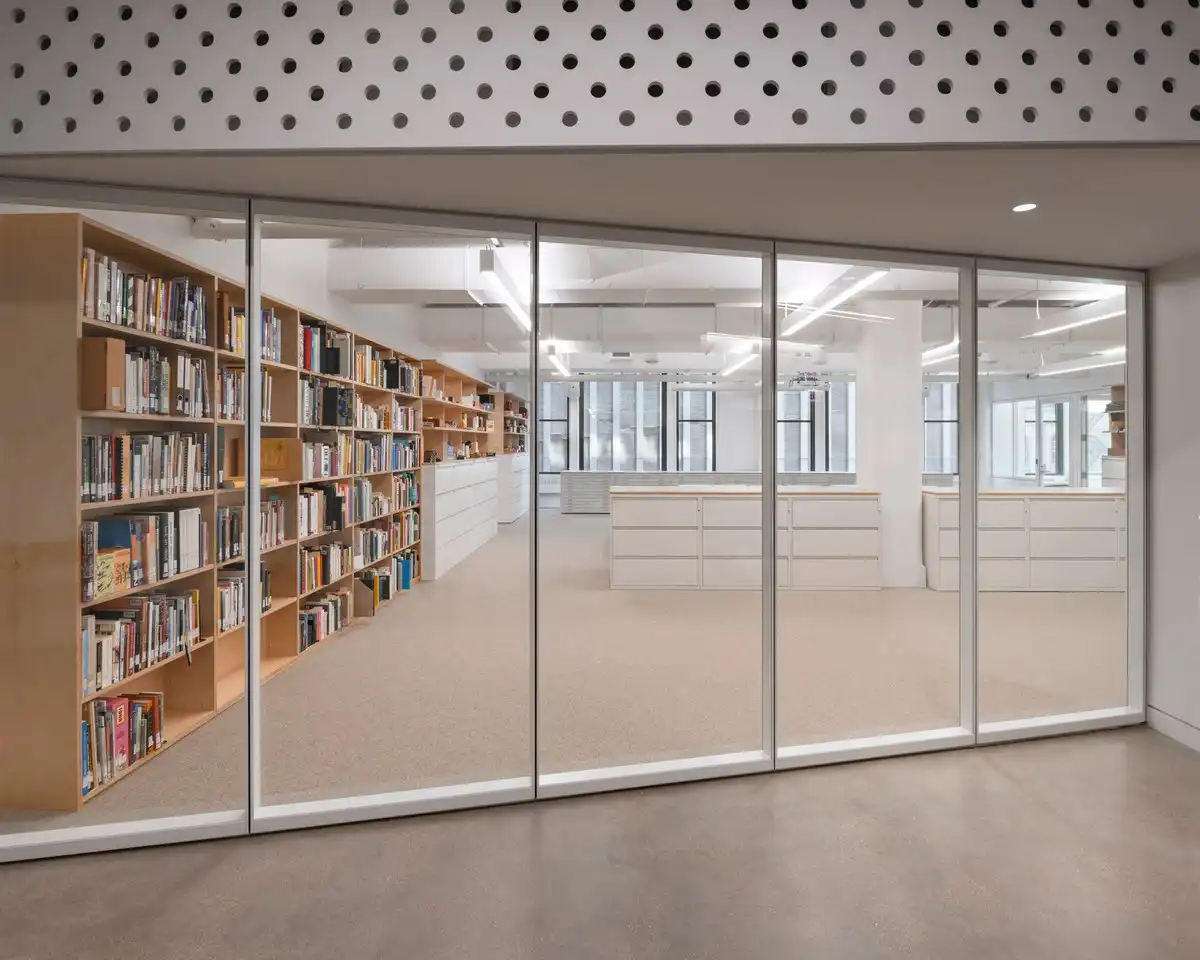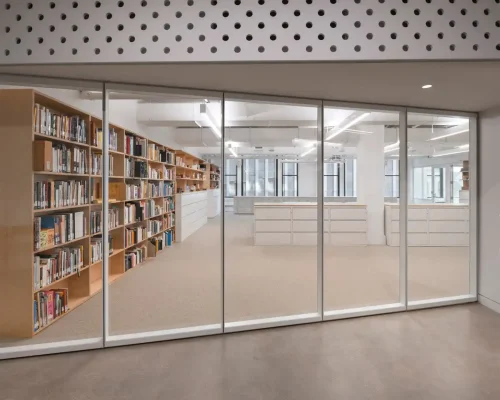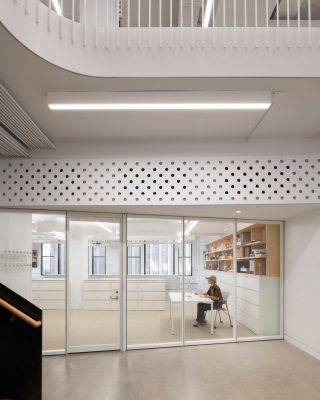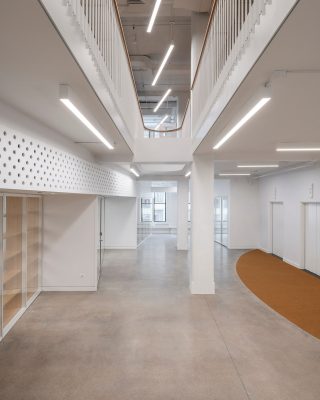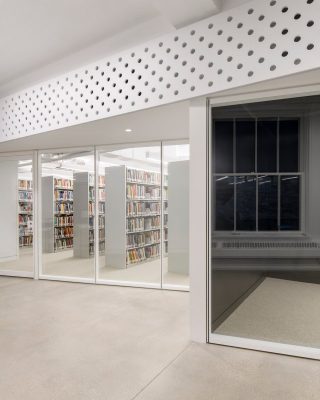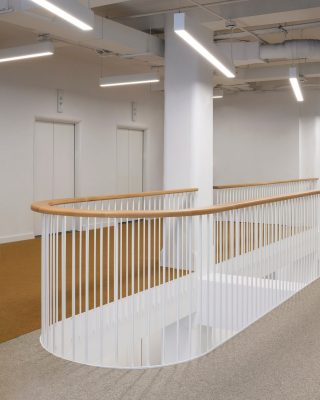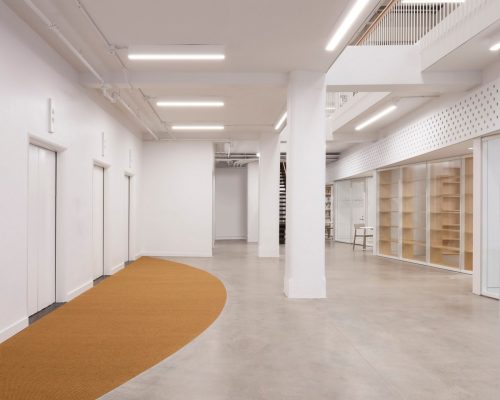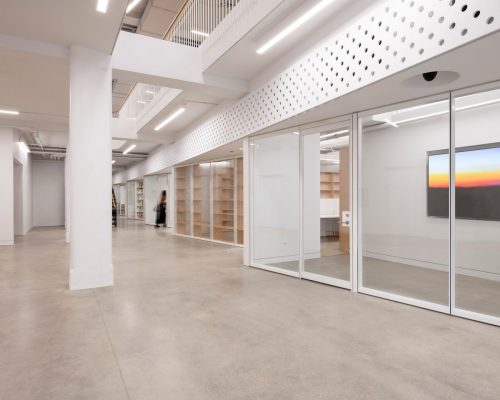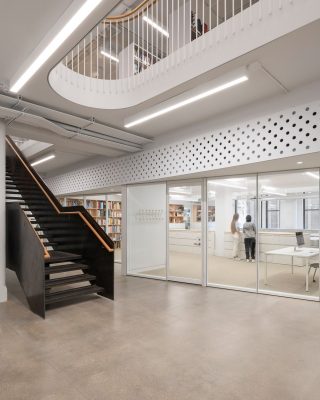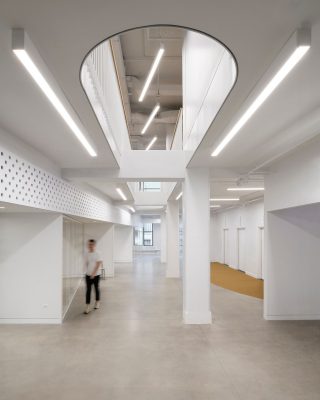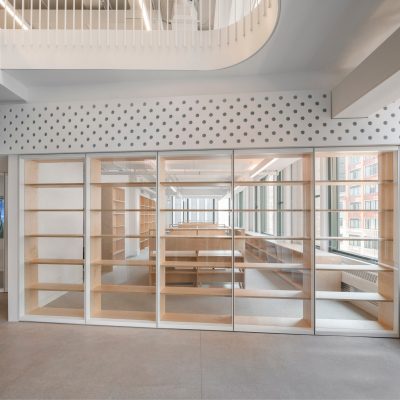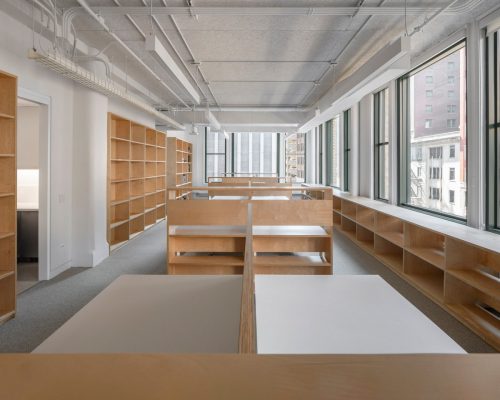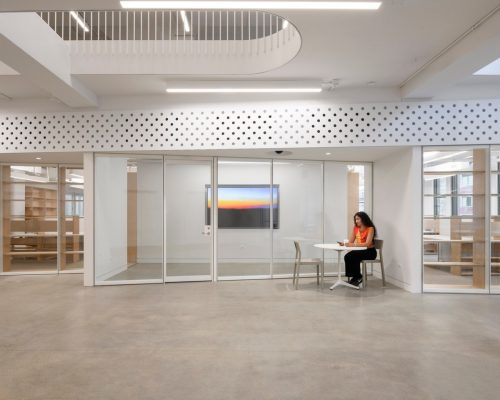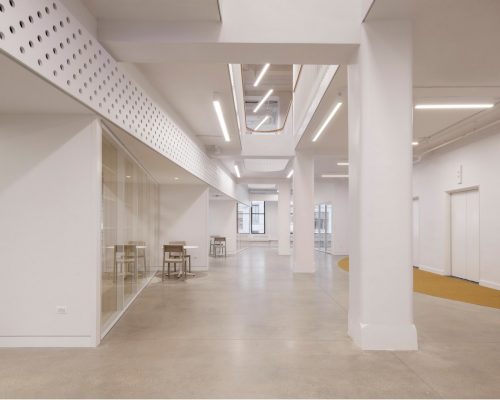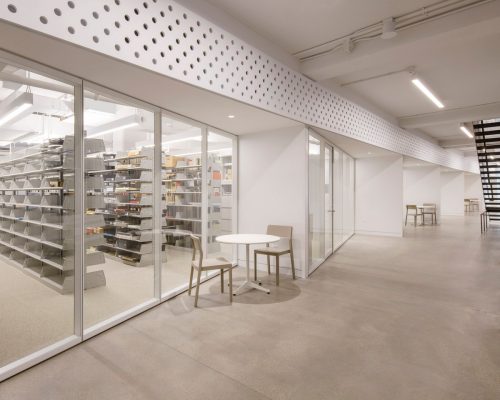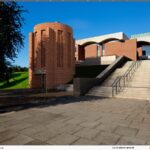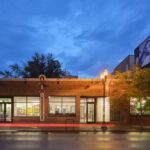School of the Art Institute, Chicago Flaxman Library, Illinois building development design, US architecture photos
School of the Art Institute of Chicago Flaxman Library Renovation
April 15, 2024
Architecture: Kwong Von Glinow
Location: Chicago, IL 60613, Illinois, USA
Photos by Mikael Olsson
School of the Art Institute, Chicago Flaxman Library, Illinois
School of the Art Institute
Located in the 1902 Sharp building by Holabird & Roche Architects at the School of the Art Institute of Chicago (SAIC), Kwong Von Glinow designed the renovation of the school’s Flaxman Library by combining two floors of library space into one inter-connected learning and social hub. As an art school in the heart of Chicago, the various academic programs are necessarily spread across different buildings.
The mission of the library renovation was, therefore, to create an engaging environment to bring students from various art disciplines together in a connected multi-level library. The Flaxman Library now functions as a campus anchor for students to explore and research the school’s collections.
The project reimagined the school’s existing Main and Special Collections Library on the fifth and sixth floors of the historic building by cutting a 5’ wide by 100’ long atrium between the two levels to create a visual and physical connection between the two floors. Working with the building’s historical framework to reveal the original Chicago steel frame structure, the atrium ties the two levels of the library together while exposing the historic structure of the building and allowing the two levels of the library to operate jointly.
Prior to the renovation, each library floor operated independently from the others with limited physical and visual access for students. The fifth floor housed the Special Collections Reading Room (the only space on the floor for students to visit by appointment only), librarian offices, and Special Collections and Main Collections stacks (accessible to staff only). A winding corridor from which all these spaces were accessed lacked natural light and smooth circulation flow. The sixth floor held and continues to hold the school’s Main Collections, accessible to all students but initially cut off from the level below.
Following the gut renovation of the fifth floor, a multi-use space termed the ‘Corridor+’ emerged to create better circulation and access for the library program while also providing semi-private reading nooks and the flexibility of a multi-use space. The Corridor+ offers a space that is not defined as a room but a flexible public space for students and staff to use informally – for meetings, studying, exhibitions and performance space. The Corridor+’s primary intent is to connect and give access to the 4 programs of the floor together – the Special Collection Reading Room, the librarian offices, and the Main Collection and Special Collection stacks.
The reconfiguration pushes all four of these secured, limited-access spaces to the south of the floorplate behind a new sawtooth-glazed storefront that defines the edge of the Corridor+. The storefront allows visual access into each of the spaces beyond, lending transparency to the significant work of the library program and its functioning while also bringing in natural light to the Corridor+. A gentle curve connects the sawtooth storefront at the transom, giving clarity to the full expanse of the floorplate and encouraging exploration down the Corridor+’s length.
By billowing out the Corridor+ with a sweeping curve the length of the floorplate, Kwong Von Glinow added 1,000 square feet of flexible study spaces for students within sawtooth niches while reorganizing the stacks such that additional bookshelves were added to the collection. Further, Corridor+ is designed to be nearly free of exposed piping and ductwork – the curvilinear custom perforated transom panel supplies and returns the air for the floor, while sprinkler heads are concealed above the panel.
The geometry of the Corridor+ allows visitors of the floor to have visual access to all spaces of the 10,000 square foot floorplate. At the same time, an expansive though narrow atrium opens up above visitors to connect to the 6th floor Main Collection library. A semicircular Coacoa mat defines a distinctive area for the fifth-floor elevator lobby within the Corridor+. A new concrete topping slab gives the appearance of an interior plaza where students can gather and interact before going into the reading room or heading up to the stacks. The original clay-tile-clad and plastered columns are left exposed in the atrium between the fifth and sixth floors to celebrate their historic sculptural form and expose the structural connection between the two levels.
The Special Collections Reading Room on level 5 is a student-facing classroom lined with custom millwork to display the procured objects and the Joan Flasch Artists’ Book Collection, and contains a dedicated area for independent researchers. The millwork is built out of Garnica Birch Plywood, serving as the backdrop for colorful objects and books.
A new stair fabricated out of half-inch-thick steel plate and off-the-shelf standard angles links the two library levels together. It is finished with a natural patina and clear coat that shows the fabrication process, including all the weld joints as part of the concept of revealing the structural clarity of the space. The stair is held off the ground by half an inch and supported on a central column to make it appear as if it were floating. White oak handrails line the interior of this otherwise dark steel sculptural piece.
On level 6, the 100-foot-long atrium is articulated with a semicircular end at each of the ‘bridges’ that cross the atrium. Above, obliquely placed linear lights reference the removed clay tile between the steel frame structure. The guard rail is attached to the existing structure along the atrium opening with a half-inch-thick steel plate from which steel rods connect to a guardrail capped with a custom curved profile out of solid white oak.
Not least, the renovation also redesigned the formerly gendered bathrooms into a single all-gender bathroom with five partition stalls. The shared area of the bathroom is wrapped in green terrazzo tiles, while the stalls’ back walls are lined in dark grey terrazzo tiles to match the dark grey partition walls and doors.
The project’s mission is to articulate a value-set for the space – to maximize space for student use, provide daylight to all spaces of the library, optimize access while giving additional uses to circulation areas, and design an efficient layout for stacks to increase capacity for a growing collection. The renovation allows for a seamless transition between the two levels of the library and makes navigating and browsing through the school’s extensive collections an enjoyable experience.
School of the Art Institute in Chicago, USA – Building Information
Architect: Kwong Von Glinow – http://www.kwongvonglinow.com/
Typology: Renovation of Main and Special Collection Libraries
Location: 37 S. Wabash Avenue, Chicago, IL 60603, 5th and 6th floors
Size: 20,000 square feet
Status: Completed 2023
Project Credits:
Structural Engineer: Goodfriend Magruder Structures
MEP Engineer: ACGI
Acoustic Consultant: Threshold Acoustics
Code and Permitting Consultant: MAPS
Millworker: Demeter Millwork
Contractor: Mortenson
Kwong Von Glinow
Kwong Von Glinow is an architecture practice based in Chicago founded on the belief that architecture is meant to be enjoyed. The practice builds the thoroughly enjoyable from the slightly familiar. Their work translates forward-looking architectural concepts into designs with broad appeal, taking an optimistic and explorative approach. The practice’s projects are about clear ideas and compelling ideals with architectural intentions that are simple, yet powerful and transformative. The practice takes on projects of varying programs to design innovative living environments, places for culture and engagement, innovative academic and institutional settings, contemporary workspaces, and not least urban public spaces.
Kwong Von Glinow was founded in 2017 by Lap Chi Kwong and Alison Von Glinow and has delivered projects ranging from single-family homes to multi-family residential buildings, public and cultural spaces, exhibitions, and designed objects. The firm’s current projects include the renovation of an 18,000-square-foot historic landmarked home for art collectors and their family; a multi-family with commercial building along Chicago Avenue; an addition to a historic Greystone; an addition to a Gold Coast residence; and the renovation of Rice School of Architecture. Kwong Von Glinow recently completed: Ardmore House, a single-family home in Chicago, the Swiss Consulate Chicago at the John Hancock Center, and the School of the Art Institute of Chicago Flaxman Library.
Photographer: Mikael Olsson
School of the Art Institute in Chicago, USA images / information received 150424
Location: 3908 N Lincoln Ave, Chicago, IL 60613, Illinois, United States
Chicago Architecture
Chicago Architecture Designs – chronological list
One Chicago, River North area, Downtown Chicago
Architects: Goettsch Partners
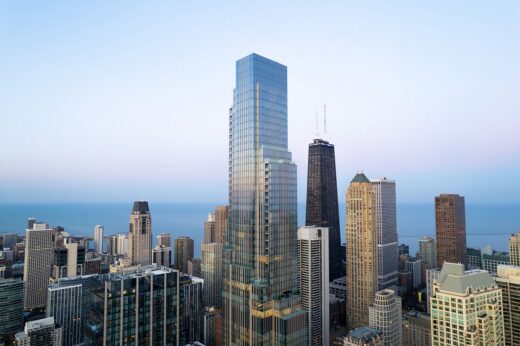
photo © Ian Jolipa
One Chicago Downtown Residences
Pepper Family Wildlife Center At Lincoln Park Zoo
Design: Goettsch Partners (GP) with PJA
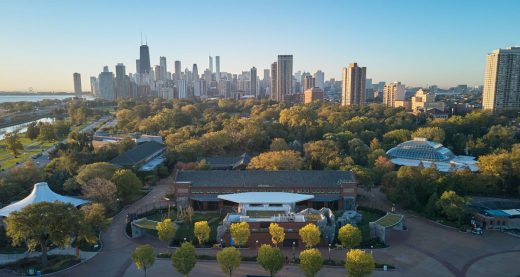
photo © Tom Harris
Pepper Family Wildlife Center At Lincoln Park Zoo
Chicago Architectural Walking Tours by e-architect
Obama Presidential Center Building
Obama Presidential Center Building
Major Chicago Buildings
Comments / photos for the School of the Art Institute in Chicago, USA designed by Kwong Von Glinow page welcome.

